1. Development trends of key automotive components
1. 1 Engine
Engine is the main part of automobile to improve efficiency and reduce pollution. The development trend of modern engine is: oil-electric hybrid power system drive, high thermal efficiency, high speed, high rise power, high specific power, high reliability, low pollution, low noise, light weight, small size, etc. Technology development direction is: gasoline engine to diesel engine, double camshaft overhead
(DOHC), variable intake and exhaust mechanism (VTEC), variable displacement engine, multi-cylinder engine V-shaped arrangement and electric vehicle, hybrid electric vehicle, solar drive and other advanced automotive technology.
1. 2 Transmission system
The transmission system consists of clutch, transmission, drive shaft and so on.
The clutch is the first part of the power transmission in the automobile, which has the functions of interrupting the power transmission and overload protection. It requires soft contact, thorough separation and light operation. Clutch according to the different transmission medium can be divided into friction clutch, hydraulic clutch and electromagnetic clutch. The car is commonly used friction clutch, hydraulic and electromagnetic although no clutch pedal, easy to operate, but the hydraulic transmission efficiency is low, and acceleration, climbing performance is poor, electromagnetic structure is complex, expensive, so the two gradually improved. The development of automobile has put forward the requirements of compact clutch, long life, light weight and high reliability.
Transmission in the car to change the speed and torque and reverse driving role, the general requirements of the transmission is the smooth shift, reliable, long life, and now there are miniaturization, lightweight requirements. Most automatic transmissions are made of hydraulic torque converter, also known as decoupling transmission, because of its convenient operation, smooth running, small vibration and impact advantages, its application is increasingly widespread.
The transmission shaft is the transmission part that transmits the power to the axle. The universal joint at both ends is the focus of the research, which requires high constant speed, reliability and high mechanical efficiency.
1. 3 Driving system
The driving system includes differential, half shaft, hub and wheel and other parts, bearing the heavy responsibility of car driving and safety, which has high efficiency, reliability, safety and other requirements, and should have the characteristics of easy installation and maintenance.
1.4 Steering system
Steering system is the part of the car to ensure the driving direction and track, its development trend is reliable, flexible (small turning radius), easy to operate. Four-wheel steering and electric power steering have great potential.
1. 5 Brake system
Safety, reliability and low noise are the developing trends of braking system. Brake from the structure can be divided into drum brake and disc brake two kinds, the traditional vehicle is the use of drum brake. Disc brake has the advantages of stable braking efficiency, self-cleaning function, small size and quality, convenient maintenance and so on. It is used more and more widely, but the price is higher. At present/front disc rear drum 0 type brake system is used more, there are also front and rear use disc brake.
Anti-lock Brak e System (ABS) is the mainstream of development. Due to the increasing speed of modern cars, the serious consequences of wheel locking have aroused widespread concern. If the front or four wheels are locked, steering will fail and travel in the original direction. If only the rear wheels are locked, tail wagging, rotation and other dangerous conditions may occur. ABS system includes speed sensor, computer control unit, actuator and so on.
To sum up, automobile technology is developing towards the direction of high speed, energy saving, environmental protection, comfort, safety, miniaturization, lightweight, high reliability, easy assembly and low price.
2. Current situation and development of automobile bearings
2.1 Engine bearing
2. 1. 1 Engine crankshaft bearings and camshaft bearings
Because of its high temperature, high speed, large load, large impact of environmental characteristics and rolling bearing installation is not convenient, in the past to slide bearings occupy an absolute dominant position, only some small power engine and motorcycle engine using sealed ball bearings. At present, most of the automobile engine bearings, under the premise of improving the bearing performance, adopt sealed ball bearings, and develop new sealing rings and lubricating materials, as well as the use of ceramic rings or ceramic rolling body.
2. 1. 2 tensioning wheel bearings
With the increase of engine speed and service temperature (RPM18 000 r /m in, temperature 150 e), the quality and performance of the bearing put forward more stringent requirements. The tensioning wheel bearing and the automatic tensioner are combined into one to form the tensioning wheel bearing unit. The product has developed from the ordinary deep groove ball bearing to the tensioning wheel bearing unit to the automatic tensioner and pulley combined into a small unit product. The product structure has the shaking fulcrum and mounting nut are placed in the round hole of the pulley, the small hydraulic tensioner is placed inside the pulley, forming a built-in automatic tensioner unit, synchronous belt type automatic tensioner has excellent function to follow the belt tension changes, can maintain stable tension, reduce the noise of the belt, and extend the life of the belt. Widely used resin pulley, aluminum shell and high performance sealed ball bearing, greatly reduce the weight of the tensioning wheel, and can use resin formability to make appropriate geometry. Good sealing performance, high rotation accuracy, reduce vibration and production costs. The structure principle and shape of typical structure tensioning wheel bearings are shown in FIG. 1 and FIG. 2 [1].
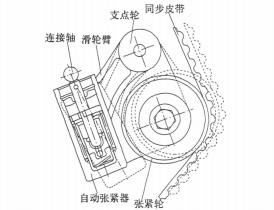
2. 1. 3 Water pump shaft coupling bearing
The pump bearing works in the environment where water droplets splash. Early, most of the use of two sets of single-row sealed ball bearings, not conducive to the realization of water pump miniaturization, lightweight, for this reason, the development of water pump shaft coupling bearing, its structure is mainly: two rows of ball and a row of ball and a row of roller (or needle) type. Because the inner ring of the bearing is integrated with the pump shaft, it is possible to miniaturize the pump bearing. Ball bearings in ball-ball structure can be designed as/three-point contact 0 or/four-point contact 0 structure to improve bearing capacity and have small axial clearance (FIG. 3).
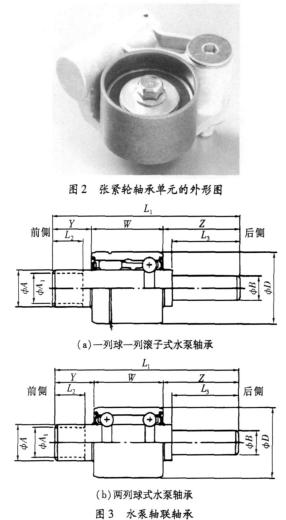
With the high performance of the engine, the engine heat increase, the pump requirements are more strict. The countermeasures adopted are: improve reliability, improve bearing seal, lightweight. In order to increase the tightness of the pump bearings, a jetting ring and a multi-lip seal were used (FIG. 4) [2].
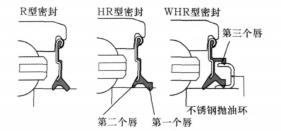
2. 1.4 alternator bearing
Because of the high performance of the engine, the alternator is required to be small and high output power, and the bearing is required to have high temperature, high speed and quiet performance. In addition, for environmental reasons, a built-in idle stop mechanism that doubles as an alternator and starter is being developed. Because of this, the service conditions of bearings are also changing.
Usually, the AC generator is driven by a V-belt. The assembly structure of the AC generator bearing is roughly divided into the front bearing bearing the load of the transmission belt and the rear bearing near the brush (Figure 5). Bearing main to bear radial force, bearing structure is a long life sealed deep groove ball bearing with high sealing performance. Bearings are required to operate reliably under the limit conditions of speed exceeding 20 000 r /m in and temperature exceeding 180 e. Bearing inner, outer ring and steel ball materials are made of high purity steel, sealing ring and cage are made of high temperature and high speed acrylic rubber and nylon 46, grease should have the performance of temperature resistance in -40 e ~ 180 e, and should be reliable lubrication under high speed conditions.
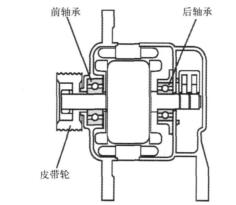
KOYO has developed generator bearings that are resistant to high temperature 180~ 200 e and meet the requirements of high speed, water resistance and vibration resistance.
2. 1. 5 Air conditioner compressor electromagnetic clutch bearing
(1) Use environment. Automobile air conditioning is driven by the engine auxiliary belt pulley rotation, and then drive the compressor work. An electromagnetic clutch that can interrupt and transmit power is used inside the pulley. The engine works continuously and only drives the compressor when the air conditioner is used. Electromagnetic clutch with double row angular contact ball bearing, outer ring rotation.
(2) Main characteristics. The maximum speed of air conditioning pulley is 7 000~ 13 000 r/m in, the maximum radial load is 1 500 N, the maximum eccentricity is 25 mm, and the maximum bearing temperature is 160 e. Therefore, greases with higher reliability are required. In addition to greases with high reliability, NSK also adopts axial cylindrical hole cage with improved lubrication performance (FIG. 6). The cage transforms a portion of the pocket hole of an ordinary single spherical plastic cage into a cylindrical shape, providing a constant supply of lubricant to the rolling body even when rotating. In addition, NSK uses high-performance contact sealing rings for outer ring rotation. Table 1 shows the representative form and performance of tight sealing rings [3].
In addition, with the miniaturization of air conditioning, the requirements for bearing miniaturization increase accordingly. Therefore, various types of bearings are developed. Table 2 shows the original structure and variant structure of electromagnetic clutch bearings. These bearings are developed from 35BD5222(double row angular contact ball bearings). According to the different bearing requirements of different hosts, the bearing structure is optimized. By reducing the axial size, two kinds of structures are formed: 35BD5212 and BY35 (four point contact ball bearings). Two structures, 35BD4822 and 35BD4522, are formed by reducing the radial size of bearings. In the field of cars, especially economy cars, these four variants are gradually replacing 35BD5222.
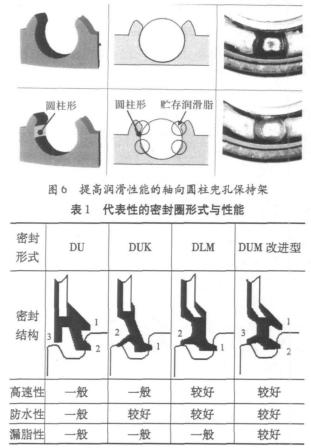
2. 1. 6 Pulley unit for auxiliary devices
The pulley unit with built-in overrunning clutch is compact in structure and light in weight. When the engine spindle speed is reduced, the auxiliary device and transmission system can be driven off instantly, so as to effectively solve the problems of high vibration noise, serious wear and reduced belt life caused by torsional vibration of the crankshaft.
As shown in FIG. 7, a set of inclined roller clutch is installed in the belt pulley. The inner sleeve of the belt pulley is connected with the main shaft of the auxiliary device through flat keys or splines to output torque to the auxiliary device. When the speed of the belt pulley is greater than the speed of the inner sleeve of the belt pulley and the spindle, the inclined support roller clutch is in the wedge tight state. At this time, the belt through the belt pulley, clutch, belt pulley inner sleeve to the auxiliary device input torque, drive the auxiliary installation rotation; When the belt pulley speed is lower than the inner sleeve and spindle speed, the inclined support roller clutch is in the overshoot state, and the belt pulley will be lower than the reverse transmission from the auxiliary spindle to the belt.
Inner sleeve and spindle rotation speed, but do not affect each other, avoid torque.
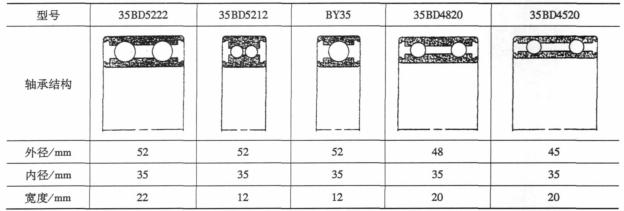
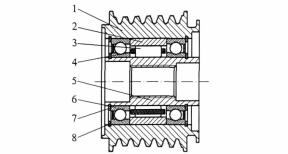
1) Belt pulley; 2) clutch outer ring; 3) Roller; 4) Cage; 5) Inner sleeve of belt pulley; 6) Rolling bearing; 7, 8) Retaining ring
The unit can be widely used in the driven auxiliary devices of automotive engines, especially for diesel engines, engines with cylinder function, low idle speed engines, and engines with high shift impact transmission.
2. 2 Clutch bearing
2. 2. 1 Clutch separation bearing
According to the different push type and pull type of the separation system, there are some differences in the structure of the clutch separation bearing (Figure 8 and 9). The dynamic analysis of the traditional clutch control system and the bearing separation shows that: When the clutch is separated, the coronal contact area of the separation fork or the separation control lever slides along the contact surface with the bearing, and the plane of action of the force deviates from the center line of the bearing (FIG. 10a and FIG. 10c, where FIG. c and d are the locally enlarged pictures of FIG. a and b respectively), resulting in inclined torque, which causes the bearing to tilt and increases wear. Resulting in rotation instability and control torque increase and other undesirable consequences. If the coronal contact surface is placed on the separation sleeve, the contact point moves along with the sleeve, so that the binding force is transmitted relatively directly to the geometric center of the bearing (FIG. 10b, 10d), basically eliminating all inclined moments.
Clutch separation bearing system works in the environment of high speed, high temperature, strong vibration and wet pollution, and there is the eccentricity between the engine output shaft and the transmission input shaft, so its life is not only related to the rated load and limit speed, but also the sealing and aligning performance is an important factor to determine its life. Commonly used thrust ball bearings, centripetal ball bearings and angular contact ball bearings generally do not have the aligning property, can not meet the use requirements, the current development of the mainstream is automatic aligning bearings. The automatic aligning bearing can eliminate abnormal noise, temperature rise and other undesirable conditions caused by the eccentricity of the rotating shaft, and also improve the life of the separated bearing (Figure 11). At the same time, the integration of separating bearing and sleeve is also conducive to miniaturization and lightweight. The use of resin sleeves can reduce weight and wear on sliding surfaces. FIG. 12 shows the structure of a partial self-aligning bearing. The high-speed performance, reliability and service life of inner ring rotary bearing are superior to that of outer ring rotary bearing under the same conditions, which is the development direction of clutch separation bearing.

2. 2. 2 clutch separation fork bearing
At present, sliding contact is generally adopted between clutch disengaging fork and disengaging sleeve. In order to reduce the friction and wear of the sliding part, improve the operating flexibility of the clutch pedal and the service life of the sleeve, a pin roller bearing is installed between the clutch separation fork and the sleeve to realize sliding friction rolling (FIG. 13).
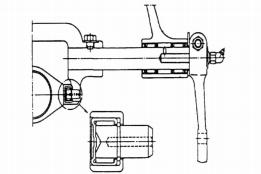
2. 2. 3 two-way clutch unit
Two-way clutch unit is an important component of automatic transmission, which can automatically adjust the direction of the clutch according to the transmission direction of the input. The clutch unit functions well according to the direction of torque input due to the symmetrical left and right shaped rollers in the inner ring cage and outer ring cage (Figure 14).
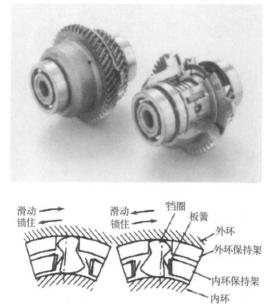
Characteristics of two-way clutch unit:
(1) Forward braking and reverse braking can be realized with only one form of special-shaped roller.
(2) According to the direction of the input torque, the forward braking and reverse braking of the clutch are controlled mechanically.
2. 3 Transmission bearing
Transmission is the most widely used bearings in automobiles, including needle roller bearings, ball bearings, cylindrical roller bearings and tapered roller bearings. The working speed of these bearings is higher, and the lubricating oil often contains impurities (iron filings, burrs, sand, etc.), so that the service life of these bearings is greatly shortened.
2. 3. 1 Needle roller bearings
The needle roller bearing is used between two shafts and the double toothed wheel which is empty sleeve on it. Its characteristics are: no force is applied when rotating, and no rotation is applied when the force is applied. When the coupling sleeve and the double gear is not engaged, there is relative rotation between the gear and the two shaft, the power on the intermediate shaft is not transmitted to the two shaft through the stop, the needle roller bearing does not force or suffer from a small force. When the coupling sleeve is engaged with the double gear, the gear and the two shaft have the same speed, there is no relative motion between the two, the needle roller bearing rotates with them, the power on the intermediate shaft through the joint action of the coupling sleeve, double gear and needle roller bearing, the power is transferred to the two shaft, at this time, the needle roller is subjected to the action of alternating stress, Because there is no relative movement between the double gear, needle roller bearing and two shafts, all three will be subjected to alternating stress in the same part, and indentation will be formed over time, causing microseismic wear. For this purpose, a needle roller bearing with unequal needle roller spacing is developed. The practical effect is very good, and the service life of the shaft and bearing is extended effectively.
2. 3. 2 Sealed ball bearings
The power of modern automobiles is constantly increasing, the speed is also constantly improving, and various structures are trying to be miniaturized and lightweight, which makes the life of the original deep groove ball bearings of the gearbox far from meeting the needs, mainly due to the invasion of foreign bodies such as debris in the lubricating oil, resulting in indentation on the groove surface. In order to improve the life of bearings, sealed ball bearings are used. The service life of the sealed and purified ball bearing developed by NSK company (FIG. 15) is more than 6 times that of the standard bearing under the same conditions, and its external size does not change much, so it has a good development prospect.
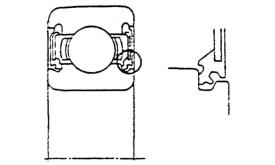
2. 3. 3 cylindrical roller bearings
Compared with ball bearings, cylindrical roller bearings have compact structure, strong bearing capacity, long service life, adapt to the needs of automobile miniaturization and lightweight, and are gradually replacing deep groove ball bearings. SKF has developed cylindrical roller bearings that can withstand high axial loads. The roller face is spherical, which greatly enhances the axial bearing capacity and improves the PV value of the bearing. HT cylindrical roller bearings change the guard edge to taper (FIG. 16), which improves the lubrication and friction strips between the end face of the roller and the guard edge, and prolonging the service life of the bearing. Another type of cylindrical roller bearing (FIG. 17) stamping outer ring, the outer ring from the original cutting machining into stamping parts, its advantages are small outer diameter size, simple axial fixation (no positioning element), the use of resin cage, light weight, low cost. But its material and processing technology requirements are extremely harsh.
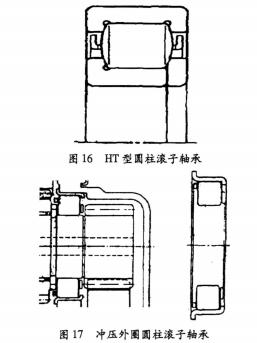
2. 3. 4 tapered roller bearings
As a shaft bearing that can bear high load and large axial force of gear, tapered roller bearings are generally used. Structurally, the roller end face of tapered roller bearing and the big guard edge of the inner ring are accompanied by sliding between each other while bearing contact load (Figure 18), so the friction torque is larger than that of ball bearing. Therefore, there is a disadvantage in terms of transfer efficiency or shift operation performance. For this purpose, the low friction torque conical roller bearing is developed. The rotating friction torque is about half of the original product in the range of medium and low speed, and can also be reduced by 20% in the range of high speed.
The integration of the front bearing of transmission and the guide sleeve and seal of clutch separation also conforms to the trend of automobile bearing unit and lightweight, which not only reduces the assembly difficulty and cost of the main engine, but also improves the assembly accuracy (Figure 19, Figure 20).
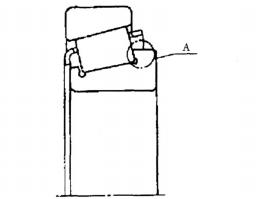
2023-01-09